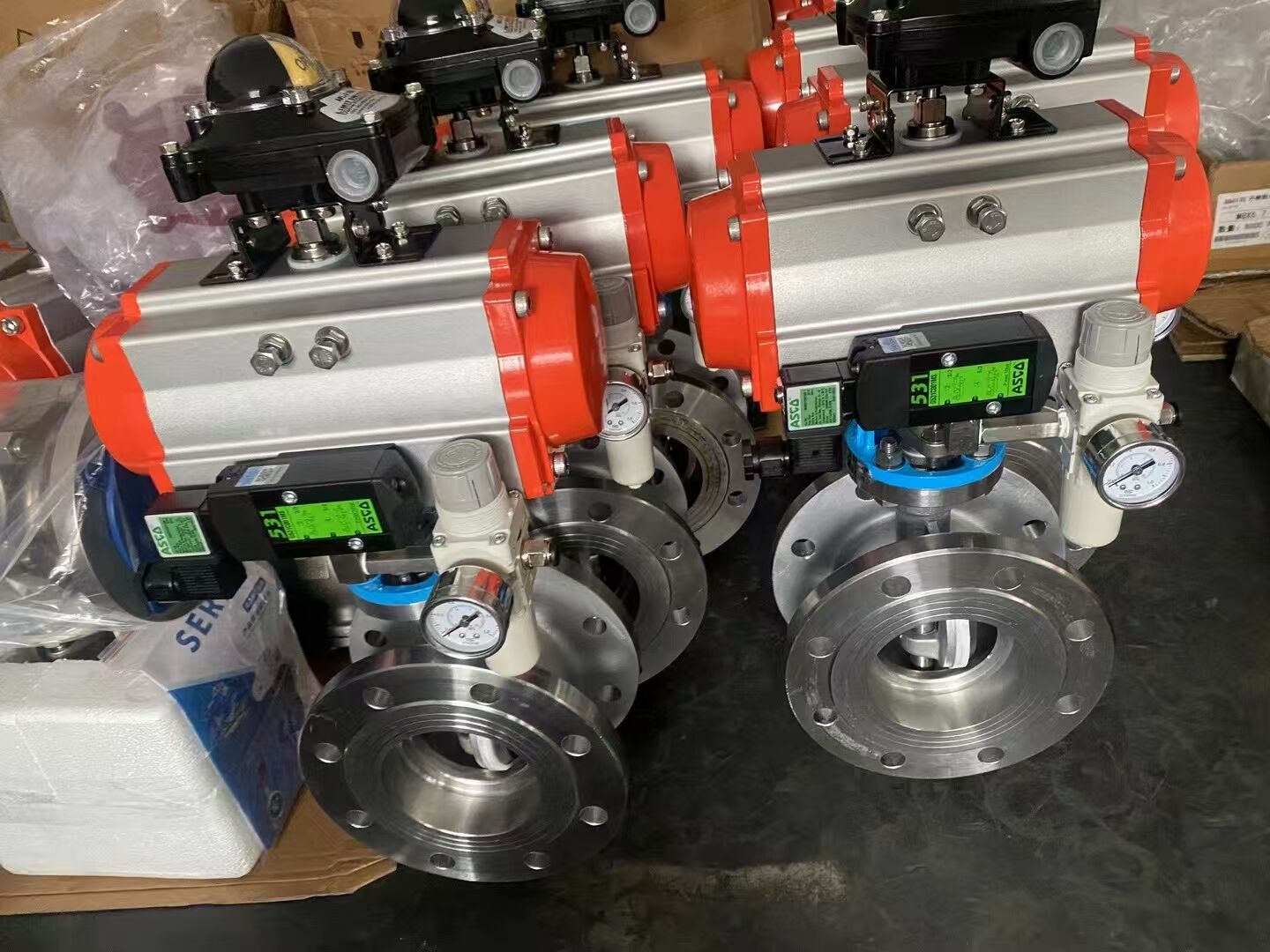The Role of Pneumatic Ball Valves in Automating Chemical Processing
Pneumatic ball valves serve as critical automation components in modern chemical processing systems, combining mechanical reliability with precise fluid control. Their unique design enables rapid isolation of aggressive media while maintaining compatibility with harsh industrial environments.
Understanding Pneumatic Actuated Ball Valves in Industrial Contexts
These valves use compressed air to rotate a perforated sphere, achieving full bore flow with 90-degree operation. Industrial models feature corrosion-resistant materials like PTFE-seated stainless steel, essential for handling acids, solvents, and high-purity chemicals. Unlike manual valves, pneumatic actuation enables remote operation in hazardous areas inaccessible to personnel.
Integration With Automated Control Systems for Seamless Operation
Modern chemical plants integrate pneumatic ball valves with distributed control systems (DCS) through positioners and I/P transducers. This connectivity enables:
- Real-time flow adjustments based on process analytics
- Automated batch sequencing for multi-product facilities
- Predictive maintenance alerts through torque monitoring sensors
Case Study: Automated Emergency Shutdown Systems in Chemical Plants
A midwestern chemical facility reduced emergency response times by 87% after upgrading to pneumatic ball valves with failsafe actuators. During a 2023 pressure excursion event, the system isolated six process sections in 0.8 seconds, preventing what analysts estimated could have been $740k in containment losses (Industrial Safety Quarterly 2024).
Trend Analysis: Rising Demand for Automation and Smart Valve Solutions
The global market for automated industrial valves is projected to grow 6.8% annually through 2030, driven by chemical sector adoption of IIoT-enabled platforms. Smart pneumatic ball valves now incorporate embedded sensors that monitor:
- Actuation cycle counts
- Seal degradation patterns
- Environmental exposure metrics
This shift toward intelligent automation helps chemical processors achieve stricter safety compliance while optimizing production throughput.
Response Speed and Control Precision of Pneumatic Actuation Systems
Why Rapid Response Times Are Critical in Chemical Pipeline Safety and Efficiency
Even half a second delay in opening or closing valves during chemical processing can lead to dangerous leaks or major problems in the production line. Pneumatic ball valves today close completely within about 0.8 seconds according to Flow Control Benchmark data from 2024, which makes them around 60 percent quicker than their electric counterparts. The difference matters a lot when dealing with substances such as chlorine or ethylene oxide. Quick response times help stop runaway reactions, prevent mixing of different product batches, and avoid situations where pressure builds up beyond what safety valves can handle. Looking at actual plant operations, the 2023 ISA Chemical Safety Report showed facilities that switched to pneumatic systems saw a drop of nearly one third in emergency situations compared to those still relying on manual controls.
Comparing Control Accuracy: Pneumatic vs. Electric Actuators in Dynamic Environments
While electric actuators offer ±0.5% positioning accuracy, pneumatic systems counter with inherent advantages for chemical pipelines:
| Factor | Pneumatic Actuators | Electric Actuators |
|---|---|---|
| Response Time | <1 second | 2-5 seconds |
| Shock Resistance | Immune to voltage spikes | Requires surge protection |
| Temperature Tolerance | -40°F to 450°F | 14°F to 140°F |
Pneumatic designs maintain ±1.5% flow control accuracy even with viscosity changes up to 500 cP, crucial for processes handling polymer slurries or wax-laden hydrocarbons.
Performance Data: Sub-Second Actuation in Modern Pneumatic Ball Valves
Leading manufacturers now deliver pneumatic ball valves with:
- 0.3-second actuation in 2" valves (tested at 100 PSI)
- 600,000-cycle durability without seal degradation
- 6,000 PSI pressure ratings for high-density fluid control
These capabilities enable precise flow adjustments in under 0.8 seconds for time-sensitive operations such as catalyst injection, where timing directly impacts reaction yields.
Balancing Speed and Precision: Addressing Concerns in Sensitive Chemical Processes
Modern pneumatic systems have overcome many of the old precision problems thanks to digital positioners that account for air compressibility issues around ±0.8% accuracy. These systems also use closed loop controls based on real time viscosity measurements, plus smart algorithms that can anticipate changes in stem friction. According to a recent study published in the Journal of Process Automation back in 2023, these advanced pneumatic valves achieved impressive results too. The research showed they maintained 99.4% reliability when adjusting pH levels, which is just as good as what electric actuators offer but with response times that are actually five times quicker. This makes them particularly valuable in applications where speed really matters without sacrificing accuracy.
Safety and Reliability of Pneumatic Actuators in Hazardous Environments
Intrinsic Safety Advantages of Pneumatic Actuators in Explosive Atmospheres
Pneumatic actuators are designed to remove the risk of igniting explosions in dangerous environments because they run on compressed air rather than electricity. Since there's no spark generation or heat accumulation during operation, these devices become the go to option for industrial sites dealing with volatile materials. According to research published last year by the Industrial Safety Consortium, factories that switched their valve automation systems to pneumatics saw a drop of around 63 percent in explosions caused accidents when compared against facilities still relying on electric actuators. Meeting ATEX and IECEx safety regulations means manufacturers build these actuators with extra care, incorporating solid materials and special seals to prevent leaks. Many plant managers have noticed real money saving benefits too. One recent survey showed companies cutting down on costly safety measures once they made the switch to pneumatic technology, as reported in the latest Valve Safety industry overview for 2024.
Fail-Safe Operation During Power Failure: Spring-Return and Air-Loss Protection
Today's pneumatic actuators come equipped with spring return features that kick in automatically when there's a power cut or air supply problem, moving valves straight to their safety positions. Take chlorine gas handling as an example of where this matters most. These pneumatic systems can fully close down in under half a second which makes them about 67 percent quicker than electric versions based on recent 2024 speed tests. The design includes two separate pneumatic chambers plus extra seals so they stay put even if air pressure starts dropping slowly over time. This kind of reliability is absolutely essential on offshore oil rigs because when emergencies hit, getting those valves shut fast stops potential environmental catastrophes from happening.
Reliability vs. Compressed Air Dependency: Managing Operational Trade-Offs
While pneumatic actuators demonstrate 98% uptime in refinery applications (PetroChem Maintenance Journal 2023), their reliability depends on consistent compressed air quality. Operators must address three key factors:
- Air Preparation: Particulate filters and dehydrators prevent valve seat erosion
- Supply Redundancy: Backup air receivers provide 45—90 minutes of buffer during compressor failures
- Maintenance Intervals: Diaphragm replacements every 8—12 months sustain optimal response times
Proactive moisture monitoring and annual endurance testing help balance compressed air dependencies with unmatched safety performance.
Material Compatibility and Performance in Chemical and Oil & Gas Applications
Corrosion-Resistant Materials for Pneumatic Ball Valves in Aggressive Media
Today's pneumatic ball valves make use of some pretty impressive materials such as 316L stainless steel, Hastelloy C-276, and even titanium when needed, all designed to handle those nasty corrosive chemicals, deal with high pressure flows, and survive in really extreme temperature conditions. According to recent market research from the Fluid Conveyance Systems industry in 2025, around one out of every four valve failures in chemical pipelines actually comes down to picking the wrong materials. That's why manufacturers are increasingly turning to PTFE seals along with electro-polished surfaces which help fight off problems like pitting and crevice corrosion. And let's not forget about the bottom line benefits either these newer designs cut down on maintenance requirements by roughly forty percent compared to older carbon steel valves, saving both time and money in the long run.
Application Example: Automated Acid Transfer Using Pneumatic Ball Valves
In hydrochloric acid transfer systems, automated pneumatic valves with PTFE-lined balls and FFKM (Perfluoroelastomer) seats achieve zero leakage over 10,000 actuation cycles. This configuration prevents acid permeation into actuator mechanisms, preserving pH stability in continuous-flow reactors.
Real-World Performance: 98% Uptime in Offshore Oil & Gas Installations
Offshore platforms using corrosion-resistant pneumatic ball valves report 98% operational uptime despite exposure to saltwater, H₂S, and fluctuating pressures. Dual-coated valve bodies (electroless nickel + epoxy) combined with automated position feedback systems minimize the need for manual inspections in these high-risk environments.
Frequently Asked Questions
What are pneumatic ball valves used for?
Pneumatic ball valves are used in chemical processing systems for precise control of fluid flow, rapid isolation of aggressive media, and remote operation in hazardous environments.
How do pneumatic ball valves function?
Pneumatic ball valves use compressed air to rotate a perforated sphere, enabling full bore flow and rapid opening/closing of the valve.
Why are pneumatic valves preferred in chemical processing?
Pneumatic valves offer advantages like faster response times, compatibility with harsh chemicals, and safety benefits in explosive environments.
Are pneumatic valves more reliable than electric actuators?
While both have advantages, pneumatic actuators offer reliability in temperature extremes and shock resistance, with rapid response times compared to electric actuators.
What materials are used in pneumatic ball valves?
Materials like 316L stainless steel, Hastelloy C-276, and PTFE seals are commonly used to ensure corrosion resistance and durability in harsh environments.
Table of Contents
- The Role of Pneumatic Ball Valves in Automating Chemical Processing
-
Response Speed and Control Precision of Pneumatic Actuation Systems
- Why Rapid Response Times Are Critical in Chemical Pipeline Safety and Efficiency
- Comparing Control Accuracy: Pneumatic vs. Electric Actuators in Dynamic Environments
- Performance Data: Sub-Second Actuation in Modern Pneumatic Ball Valves
- Balancing Speed and Precision: Addressing Concerns in Sensitive Chemical Processes
- Safety and Reliability of Pneumatic Actuators in Hazardous Environments
- Material Compatibility and Performance in Chemical and Oil & Gas Applications
- Frequently Asked Questions



